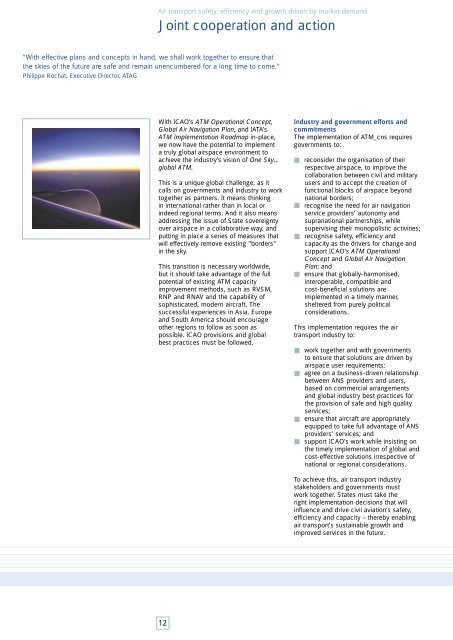ATAG Corporate brochure
ATAG Corporate brochure
ATAG Corporate brochure
Create successful ePaper yourself
Turn your PDF publications into a flip-book with our unique Google optimized e-Paper software.
Air transport safety, efficiency and growth driven by market demand<br />
Joint cooperation and action<br />
"With effective plans and concepts in hand, we shall work together to ensure that<br />
the skies of the future are safe and remain unencumbered for a long time to come."<br />
Philippe Rochat, Executive Director, <strong>ATAG</strong><br />
With ICAO’s ATM Operational Concept,<br />
Global Air Navigation Plan, and IATA’s<br />
ATM Implementation Roadmap in-place,<br />
we now have the potential to implement<br />
a truly global airspace environment to<br />
achieve the industry’s vision of One Sky…<br />
global ATM.<br />
This is a unique global challenge, as it<br />
calls on governments and industry to work<br />
together as partners. It means thinking<br />
in international rather than in local or<br />
indeed regional terms. And it also means<br />
addressing the issue of State sovereignty<br />
over airspace in a collaborative way, and<br />
putting in place a series of measures that<br />
will effectively remove existing "borders"<br />
in the sky.<br />
This transition is necessary worldwide,<br />
but it should take advantage of the full<br />
potential of existing ATM capacity<br />
improvement methods, such as RVSM,<br />
RNP and RNAV and the capability of<br />
sophisticated, modern aircraft. The<br />
successful experiences in Asia, Europe<br />
and South America should encourage<br />
other regions to follow as soon as<br />
possible. ICAO provisions and global<br />
best practices must be followed.<br />
12<br />
Industry and government efforts and<br />
commitments<br />
The implementation of ATM_cns requires<br />
governments to:<br />
reconsider the organisation of their<br />
respective airspace, to improve the<br />
collaboration between civil and military<br />
users and to accept the creation of<br />
functional blocks of airspace beyond<br />
national borders;<br />
recognise the need for air navigation<br />
service providers’ autonomy and<br />
supranational partnerships, while<br />
supervising their monopolistic activities;<br />
recognise safety, efficiency and<br />
capacity as the drivers for change and<br />
support ICAO’s ATM Operational<br />
Concept and Global Air Navigation<br />
Plan; and<br />
ensure that globally-harmonised,<br />
interoperable, compatible and<br />
cost-beneficial solutions are<br />
implemented in a timely manner,<br />
sheltered from purely political<br />
considerations.<br />
This implementation requires the air<br />
transport industry to:<br />
work together and with governments<br />
to ensure that solutions are driven by<br />
airspace user requirements;<br />
agree on a business-driven relationship<br />
between ANS providers and users,<br />
based on commercial arrangements<br />
and global industry best practices for<br />
the provision of safe and high quality<br />
services;<br />
ensure that aircraft are appropriately<br />
equipped to take full advantage of ANS<br />
providers’ services; and<br />
support ICAO’s work while insisting on<br />
the timely implementation of global and<br />
cost-effective solutions irrespective of<br />
national or regional considerations.<br />
To achieve this, air transport industry<br />
stakeholders and governments must<br />
work together. States must take the<br />
right implementation decisions that will<br />
influence and drive civil aviation’s safety,<br />
efficiency and capacity – thereby enabling<br />
air transport’s sustainable growth and<br />
improved services in the future.

















